

5 Characteristics Needed for Future-focused Sensing. "There is no shortcut; there is no algorithm.
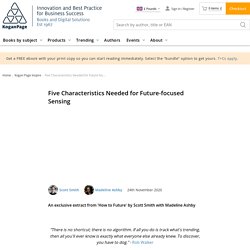
If all you do is track what's trending, then all you'll ever know is exactly what everyone else already knew. To discover, you have to dog. " - Rob Walker. Ten trends to watch in the coming year. If 2021 was the year the world turned the tide against the pandemic, 2022 will be dominated by the need to adjust to new realities, both in areas reshaped by the crisis (the new world of work, the future of travel) and as deeper trends reassert themselves (the rise of China, accelerating climate change).

Here are ten themes and trends to watch in the year ahead. 1 Democracy v autocracy. America’s mid-term elections and China’s Communist Party congress will vividly contrast their rival political systems. The World Ahead 2022. Shaping the future with 3D mapping. News and business predictions for 2022. What’s covered most in global media and what’s most pressing are rarely in sync.
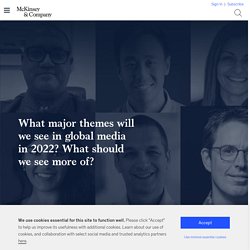
So what themes will persist in 2022, and what new threads need to emerge? McKinsey Global Publishing’s Raju Narisetti asked dozens of journalists and media leaders around the world for their own perspectives on what’s to come—their personal lens on what’s likely to be covered heavily in 2022, and what issues might fly under the radar. They were asked to mull two big questions: Global Economics Intelligence executive summary, October 2021. Despite the challenge of pandemic-related disruptions, the global economy is exhibiting strong overall demand.
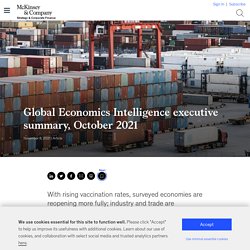
Industrial growth can be measured in almost all surveyed countries and the eurozone. The global purchasing managers’ indexes (PMIs) for manufacturing and services show healthy expansion, with respective readings of 54.1 and 53.4. Unemployment is generally falling, and world trade has effectively recovered to prepandemic levels. The public-health situation has improved in most surveyed economies, especially as vaccines against COVID-19 have become more available and vaccination programs are finally making real progress. Public-health experts are guardedly optimistic but urge continued caution and emphasize the need for even wider vaccine distribution and acceptance. Signals of Business Change. Why does it matter?
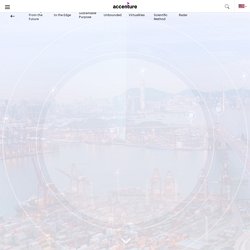
Breaking the physical limits of their supply chains enables organizations to do more with less, and thereby meet customers’ growing expectations for order fulfillment in a cost-efficient way. Here are some key opportunities in embracing this approach: 1. Decoupling fulfillment from distance. Signals of Business Change - Signal 3: Sustainable Purpose. Why does it matter?
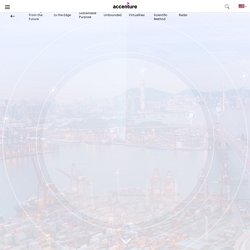
Breaking the physical limits of their supply chains enables organizations to do more with less, and thereby meet customers’ growing expectations for order fulfillment in a cost-efficient way. Here are some key opportunities in embracing this approach: 1. « Nous sommes en rupture de stock » : la nouvelle normalité? The U.S. Economic Recovery Is Slowing Down. Don’t Be Alarmed. There are a number of factors currently driving uncertainty in the U.S. economy.
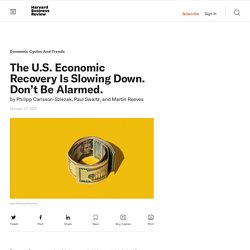
Consumer confidence has dipped markedly in recent weeks, while firms’ outlook has dimmed too, as seen in falling PMIs. Inflation, though... As business leaders enter the fall, a confluence of negatives is clouding their outlook on the economy. The big bounce back from last year’s trough has lost steam, stimulus is fading, and a plethora of softer economic data is weighing on sentiment. Global Economics Intelligence executive summary, September 2021. Industry continued to expand in August, and forward indicators point to further near-term growth.
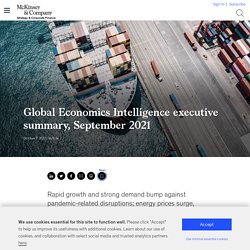
The pace of growth slowed, however, as strong demand crossed pandemic-related disruptions; the global purchasing managers’ indexes (PMIs) for manufacturing and services in August were 54.1 and 52.9, respectively, compared with readings of 55.4 and 56.3 in July (Exhibit 1). Growth momentum remained strongest in developed economies, but economic data in India and Brazil were also positive. The results are consonant with the OECD’s composite leading indicators, which moderated slightly in August but continue to point to strong growth above prepandemic averages. We strive to provide individuals with disabilities equal access to our website. If you would like information about this content we will be happy to work with you. Forward Thinking on economies beyond COVID-19 with Michael Spence. In this episode of the McKinsey Global Institute’s Forward Thinking podcast, co-host Janet Bush speaks with distinguished economist Michael Spence.
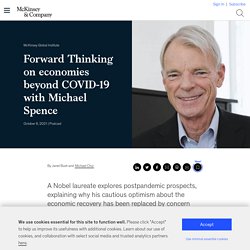
He is professor of economics and dean emeritus at the Stanford Graduate School of Business, senior fellow at the Hoover Institution at Stanford, senior professor at SDA Bocconi, and Nobel laureate in Economic Sciences, 2001. Spence reflects on some of the major shifts and challenges ahead, from rolling out vaccine programs in lower-income economies to tackling climate change. He answers questions like: Is the current fragility in supply chains a sign that something more fundamental is happening that could affect the course of globalization? Will new ways of working that emerged during the pandemic persist and, if so, what are the broader economic implications? Signals of Business Change. Why does it matter?
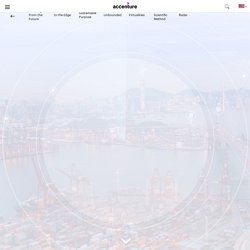
Breaking the physical limits of their supply chains enables organizations to do more with less, and thereby meet customers’ growing expectations for order fulfillment in a cost-efficient way. Here are some key opportunities in embracing this approach: 1. Decoupling fulfillment from distance. A Futurist’s Guide to Preparing Your Company for Constant Change. Book Summary: How to Future. Report: Signals of Business Change - Business Futures 2021. Why does it matter? Breaking the physical limits of their supply chains enables organizations to do more with less, and thereby meet customers’ growing expectations for order fulfillment in a cost-efficient way.
Here are some key opportunities in embracing this approach: 1. Decoupling fulfillment from distance. Signals of Business Change - The essential radar that leaders need to see and seize the future. Why does it matter? Breaking the physical limits of their supply chains enables organizations to do more with less, and thereby meet customers’ growing expectations for order fulfillment in a cost-efficient way.
Here are some key opportunities in embracing this approach: 1. Decoupling fulfillment from distance. Why traditional budgeting is the antithesis of Agile – and what to do about it. Most organizations are born small and born agile. They are nimble, trusting, collaborative, non-bureaucratic and purpose-driven. But few want to remain small. How to spot the next macrotrends. Global Economics Intelligence executive summary, July 2021.
The COVID-19 pandemic worsened in recent weeks, as the Delta variant of the virus spread to more countries and the total number of cases officially logged soared past one-half million per day. In the last four weeks, active cases globally have risen from 11.3 million to 14.1 million. The number of deaths is also rising, and is now about two-thirds as high as it was at the peak of the previous wave (in April). Greater vaccine availability in some Western countries has raised hopes that renewed restrictions can be avoided. However, health authorities and governments are struggling to gain the cooperation of the willfully unvaccinated. So far none of the thousands of virus variants that have been tracked, including the Delta variant, has posed an additional danger to those who have been vaccinated.
Executive Perspectives on the Latest Global Topics. Global Economics Intelligence executive summary, June 2021. Led by the United States and China, the world economy has resumed growth trajectories last seen in 2019. The OECD leading indicators point to growth above long-term averages in the United States and the eurozone, with further momentum building in China. While manufacturing and trade have led growth for many months, services expansion returned in May and June, as more economies have reopened. Harvard Business Review. Podcast: Episode 05: What Makes a Business Future-Ready? The business trends shaping the post-COVID economy. Holoptic Foresight Dynamics: An Evolutionary Model for Co-Creating the Future (Part 1) Holoptic Foresight Dynamics: An Evolutionary Model for Co-Creating the Future (Part 2) Looking beyond the pandemic: Could the world economy gain more than it lost to COVID-19?
Business Futures 2021: Signals of Business Change. Global Economics Intelligence executive summary, May 2021. Roadmap for a Post-Pandemic World. The four global forces breaking all the trends. Office of the Director of National Intelligence - Global Trends. Create the Future + the Innovation Handbook: Tactics for Disruptive Thinking (10 March 2021) by Jeremy Gutsche. Three post-pandemic predictions for the world of work. The 11 Sources of Disruption Every Company Must Monitor. Global Economics Intelligence executive summary, March 2021. Staying Ahead of Disruptions with Your Business Model. Report: Will productivity and growth return after the COVID-19 crisis? The coronavirus effect on global economic sentiment. The state of corporate restructuring in Europe. The State of Globalization in 2021. Global Economics Intelligence executive summary, February 2021. 2021 Predictions Series – Emergence.
On Organization Guidance System (OGS) LinkedIn by Annapurna A. 99 big thinkers on what our world after coronavirus might look like. The coronavirus effect on global economic sentiment. Shaping A Better Future - Going Beyond Business As Usual. Poem 'The Hill We Climb': Read Amanda Gorman's inaugural poem.
Nine keys to becoming a future ready company. Through the Looking Glass. Fjord Trends 2021 - Emerging Trends in Business. Covid-19 Has Upended Business. Which Trends Will Stick? IFTF Foresight Tool: Map Complex Impacts During a Time of Uncertainty. 6 future retail trends for 2021, 2025 and 2030. How Futurists Cope With Uncertainty. Get Ready for These 4 Changes Coming to the Business World in 2021. How to Future: Leading and Sense-making in an Age of Hyperchange (September 2020) by Scott Smith and Madeline Ashby.
How CEOs and boards drive long-term value creation. Global Economics Intelligence executive summary, August 2020. Scenario Planning Presentation in PowerPoint, Google Slides, and Keynote. On the evolution of forecasting. 2030: How Today's Biggest Trends Will Collide and Reshape the Future of Everything (August 2020) by Mauro F. Guillen. The quickening - If you’re feeling whiplash, it might be the ten years forward we just jumped in 90 days’ time. Korn Ferry Briefings Issue 44. Six Ways to Think Long-term. A Cognitive Toolkit for Good Ancestors. COVID-19 was a textbook black swan event. How can data help drive the phase of reopening? Report: Fjord Trends 2020 - Emerging Trends in Business.
How to Future: Leading and Sense-making in an Age of Hyperchange (July 2020) by Scott Smith and Madeline Ashby. Thinking Like A Futurist is the #1 Skill For Leaders: Here's How to Master It. Demystifying modeling: How quantitative models can. War games can help mitigate competitor neglect bias. The “New Normal” Is a Myth. The Future Won’t Be Normal at All. Three Paths to the Future. Contingency planning: is it a waste of time? Strategic Foresight: Accelerating Technological Change (2020) Sarah Lai-Yin Cheah. Planning for uncertainty: Performance management under COVID-19. Companies Need to Prepare Today to Survive the Next 18 Months. Augment Your Long-Term Strategy with a Near-Term Resilience Plan. Insights from Foreign & Commonwealth Office - IFLP.
We Need a Stress Test for Critical Supply Chains. Scenario Development Sprints. A futurist on navigating change forced by the pandemic: fight the fear. COVID-19: How business leaders should plan ahead - Podcast. Will You Be Ready When the Next Disaster Strikes? Preparing Your Business for a Post-Pandemic World. Sensing and Shaping the Post-COVID Era. Plan-ahead teams: Getting ahead of the next stage of the crisis. Planning for the Unexpected. Special Update: How futurists deal with uncertainty. That Are Expected to Change Everything by 2050. The New Strategist: Shape your Organization and Stay Ahead of Change (2020) by Prof. em Dr. Günter Müller-Stewens.
Long-term vs short-term. The Power of Algorithmic Forecasting. Quatre choses cruciales à surveiller dans la décennie 2020. How Vigilant Companies Gain an Edge in Turbulent Times. How Vigilant Companies Gain an Edge in Turbulent Times. Seeing Around Corners: How to Spot Inflection Points in Business Before They Happen (2019) by Rita McGrath. Where companies with a long-term view outperform their peers.